Good morning Marco, how many years have you been working with Murano glass?
I have been working in the furnace for almost 30 years and have experience in various techniques, from blowing to glass fusing and in the production of both classic and modern chandeliers.
How many parts does a Murano chandelier consist of?
There are many individual pieces that make up a chandelier, such as cups, arms, saucers, plates, balls, stems, rosettes, finals, pendants, flowers, just to list the main ones. Each of these pieces requires different processing, which also varies depending on the requested style. It is a type of work that is called “artistic” in the context of Murano.
How is a chandelier made?
A project with specific dimensions is needed and, depending on the design, the shape of the arms is made and the measurements of the necessary molds are calculated, such as the “sanca” that is used to create the arms so that they have the same size and inclination. Everything must be in the correct proportions.
Sometimes these measurements are indicated but it may be necessary to calculate them. Classic Venetian artistic chandeliers are entirely handmade because there are decorations called morise on the cups and saucers, while the components of modern chandeliers, which require particular textures, are made of blown glass on a mold.
A modern chandelier is more technical while the classic one is more artistic and it is definitely more complex, the production times are much longer and then you need a lot of skill because, if you have to make something by hand, you cannot make mistakes with the measurements, you use compasses, take measurements, etc…
How do you think the lighting sector in Murano has changed?
There are many companies that make chandeliers on the island, but the sector has certainly changed. The design of contemporary homes now prefers minimalist furnishings, but there is a lot of interest from hotels, restaurants, and non-European countries.
In general, in my opinion, the taste is moving towards the modern chandelier, which can also be seen as a reinterpretation of the classic. Often, the structure is similar, but the shapes are more linear, the colors and decorations enhance the lighting.
Making chandeliers is a source of great satisfaction for me because it is a precise job on many small elements from which a unique piece that conveys balance and beauty emerges. Despite market changes, the tradition of Murano continues to be an added value, especially abroad, where the skill and beauty of Venetian chandeliers are appreciated.





